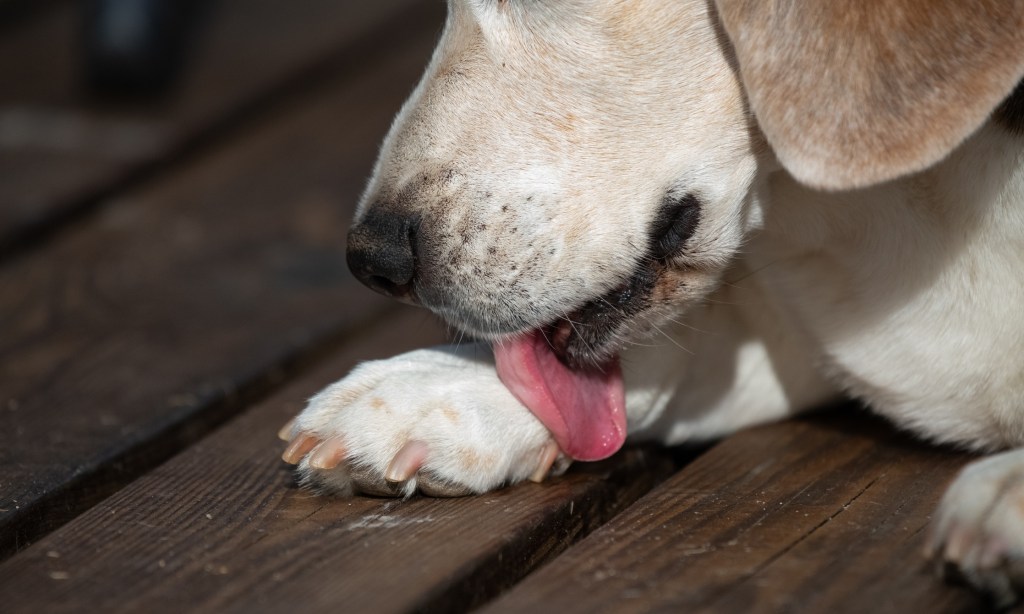Table of Contents
Your dog has been stung by a bee or wasp – now what? Read on to learn about first aid that will help them recover as quickly as possible and signs that your dog needs veterinary attention ASAP.
How to Treat Bee and Wasp Stings in Dogs
- Bee and wasp stings are painful, so even the most mild-mannered dog may bite. When in doubt, place a temporary muzzle on your dog before attempting any of the following.
- Gently part your dog’s fur and look for the stinger. If you can find it, carefully remove it with tweezers or use a credit card or similar object to scrape it out of the skin.
- Apply a cool compress to the area to reduce swelling and pain. Ice wrapped in a towel works well.
- Mix some baking soda with a little water and apply the paste to the site.
- Monitor your dog closely for signs of an allergic reaction — hives, facial swelling, weakness, vomiting, diarrhea, itching, drooling, pale or blue mucous membranes, difficulty breathing, seizures, or collapse.
- Call your veterinarian if you’re concerned about your dog’s well-being. The doctor may recommend an appropriate dose of an oral antihistamine or tell you that you should bring your dog to the veterinary clinic.
What does a bee sting look like on a dog?
Sometimes it’s obvious when a dog has been stung by a bee or wasp, but if you’re unsure, part your dog’s fur so you can get a good look at their skin. The area around a bee sting will usually be red and swollen. You may see a stinger embedded in the skin or a small puncture wound at the center. Bee stings can be painful and itchy for dogs. All of these signs usually resolve within 12-24 hours.
How to remove a bee stinger from a dog?
If you find a stinger stuck in your dog’s skin, removing it will speed up the healing process. Either scrape it out of your dog’s skin with the edge of a credit card (or something similar) or use tweezers to remove the stinger. If necessary, you can fashion a temporary muzzle for your dog using a long piece of gauze or a leash.
Be careful if your dog has been stung in an especially sensitive area like inside the mouth or around the eyes and nose. Call your veterinarian for advice if you are worried that you won’t be able to safely remove the stinger.
When to seek medical attention
Most dogs recover uneventfully from bee and wasp stings, but serious reactions are possible. A dangerous allergic reaction called anaphylaxis is rare but becomes more likely if a dog has had severe reactions to bee stings in the past. Signs of anaphylaxis develop within minutes of a sting and include:
- Weakness
- Hives
- A swollen face
- Itching
- Drooling
- Vomiting
- Diarrhea
- Difficulty breathing
- Pale or blue mucous membranes
- Seizures
- Collapse
- Sudden death
Dogs who are not allergic to bee stings can develop similar symptoms if they are stung by massive numbers of bees. A good rule of thumb for determining if a dog might be at risk is approximately 9-10 bee or wasp stings per pound of body weight.
Delayed responses to bee and wasp stings are rare but possible. For example, dogs can develop delayed allergic reactions, organ damage, and immune-mediated hemolytic anemia or thrombocytopenia in the 3 to 14 days following bee and wasp stings. Watch your dog closely for two weeks after they are stung and call your veterinarian if notice any worrisome symptoms.
FAQs
What can you give a dog for a swollen bee sting?
Remove the stinger if it is present and apply an ice pack to the area for 5 minutes or so. Then, make a paste of baking soda and water and put it on the affected skin. Repeat in a couple of hours if necessary.
Call your veterinarian for advice if you think your dog needs an antihistamine like Benadryl (diphenhydramine) for a bee or wasp sting. Most dogs do not need to take an antihistamine after being stung by a bee or wasp. If your dog is showing signs of an allergic reaction, the veterinarian may recommend that you give Benadryl (diphenhydramine), but you should also bring your dog to the clinic for an exam and possible further treatment.
Can dogs get sick from bee stings if left untreated?
Most dogs do not get sick from bee stings even if they are untreated. Removing the stinger and applying a cold compress and a paste made from baking soda and water can relieve discomfort and speed up the healing process. Monitor your dog for signs of an allergic or other serious reaction and call your veterinarian for advice if you notice any worrisome symptoms.
How long after a bee sting will a dog have a reaction?
Anaphylaxis (a type of severe allergic reaction) generally occurs within minutes of a bee sting. Delayed reactions are possible in the 3-14 days after a bee or wasp stings, but they are very rare.
How long does it take for a dog to recover from a bee or wasp sting?
As long as a dog doesn’t have a severe reaction to a bee or wasp sting, they should be back to normal within 12-24 hours. The site of the sting may still be a little red and itchy, but they shouldn’t have any other symptoms.
What do vets do for bee stings?
When a dog has been stung by a bee, a veterinarian can remove the stinger and treat the site of the sting with topical medications to ease discomfort. If necessary, they can also give the dog an injection of diphenhydramine or a corticosteroid to reduce itching, swelling, redness, and pain.
Veterinary attention is essential if a dog is having an allergic reaction to a bee or wasp sting. In these cases, dogs may require treatment with diphenhydramine, epinephrine, corticosteroids, intravenous fluids, oxygen, and more. Dogs who have had an anaphylactic reaction will also need to be hospitalized for close monitoring and support.








